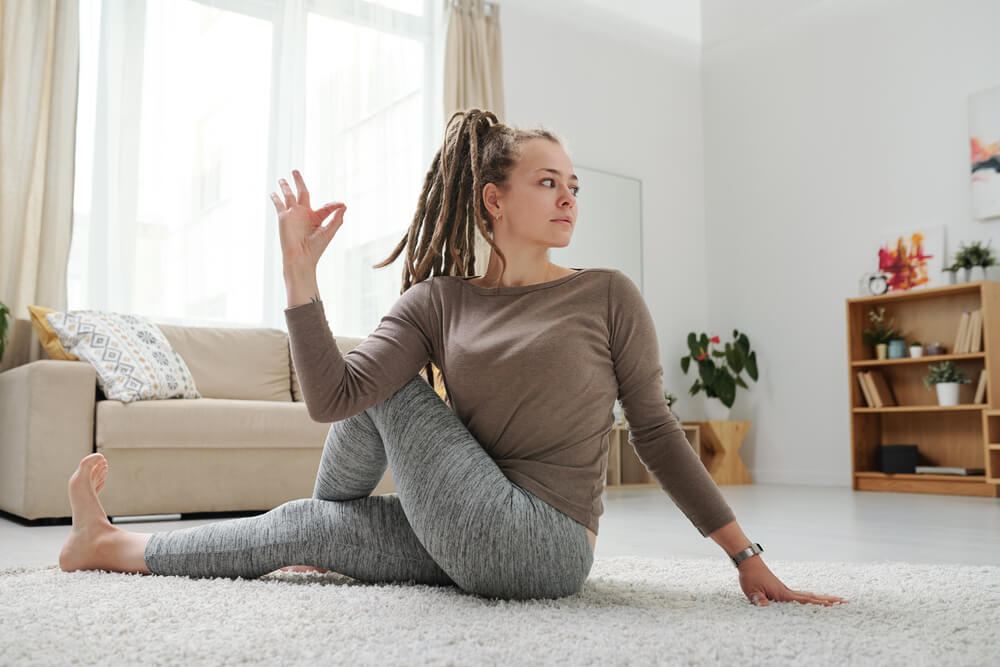Creating the perfect yoga space at home doesn’t have to be difficult. Using feng shui principles, you can easily create a serene and inviting space that will help you to relax and find inner peace. Here are some simple tips to get you started…
How do I set up a yoga space at home?
Setting up a yoga space at home is the best way to ensure that you practice regularly and can focus on your wellness. Start by clearing out an area of your house that is quiet and distraction-free, ideally near a window in which you can take in some natural light.
Next, set up a comfortable yoga mat, bolster, or if possible, a luxe folding couch. Make sure that this space also includes any props you might need such as blocks, straps, or blankets for extra support.
Lastly, create an atmosphere with minimal clutter and relaxing accents like incense or essential oils to promote calmness and mental clarity throughout your practice.
With these guidelines in mind, you’ll soon be able to perfect the art of self-practice from the comfort of your own home.
How to turn your living room into a yoga studio?
Transforming your living room into a yoga studio can be a great way to practice yoga without ever having to leave the comfort of your home. Start by decluttering the space and creating an inviting area with dim lights and calming music.
Gather all the items that you need for your practice such as bolster, blocks, and straps along with some comfortable clothing, before settling in. Once equipped and set up, start posturing yourself towards stillness.
Studies have shown that doing yoga at home gives you greater clarity and focus, so why not tap into the power of yoga right inside your living room?
What colors are calming for the yoga room?
When it comes to creating a tranquil, calming atmosphere for practicing yoga, the colors in the space can be an integral part of a relaxing environment. Soft hues such as blues, greens, purples, and whites often evoke a feeling of peace and balance.
Neutral shades like beiges or tans can also provide a soothing atmosphere for a yoga room.
If possible, including plants and natural materials will help form a more tranquil atmosphere. For example, adding bamboo flooring or ceiling beams can lend an organic feel as well as many spiritual associations with nature.
What is the most spiritual form of yoga?
The most spiritual form of yoga is often said to be kundalini yoga, sometimes referred to as the “yoga of awareness”. Kundalini yoga focuses on the practice of releasing energy from various parts of your body and attempting to reach higher states of consciousness.
It also emphasizes emotional and spiritual well-being, combining breathing exercises with postures to awaken a person’s physical, mental, and spiritual energies.
While this form of yoga is thought to be especially beneficial for those looking for a sense of connection with the divine, any type of yoga can serve a spiritual purpose if practiced with intention and mindfulness.
How do you create a perfect meditation space?
Creating the perfect meditation space is essential to get the most out of your practice. The key is to create an environment that promotes soothing and mindful relaxation. The space should be big enough for you to adequately spread out, but not so big as to make it feel overwhelming.
Start by selecting a comfortable chair or cushion for seated meditation; this will be the base for your practice. Consider adding elements like calming artwork and inspirational quotes that help foster calmness and meditative thoughts.
Investing in some good quality candles and incense can also help promote relaxation during meditation sessions. Finally, incorporate music of your choice – either instrumental or a collection of calming playlists – to further enhance the meditative mood.
Ultimately, creating a perfect meditation space is all about curating an environment that works best for you, enabling you to focus on letting go of stresses and achieving inner peace.
Which direction should a meditation room face?
When deciding which direction to orient a meditation room, the choice should be thought through carefully. A facing toward the east is said to bring in new energy and provide an uplifting feeling.
A south-facing meditation room allows natural light to fill the space while westward or northward windows can provide an atmosphere of calm. The view outside can also be customized to completely relax during meditative practices.
For example, looking out toward nature scenes or facing peaceful bodies of water can encourage the development of an intimate and calming atmosphere for introspection and relaxation.
With forethought and planning, one can truly create a perfect environment for peaceful reflection and energy renewal.
Conclusion
You don’t need a professional feng shui consultant to create a serene and uplifting yoga space at home. By following the simple tips in this article, you can easily arrange your furniture and décor to encourage good energy flow and promote relaxation.
Creating a beautiful and inspiring yoga space at home is not only possible with feng shui principles – it’s easy and fun too!














